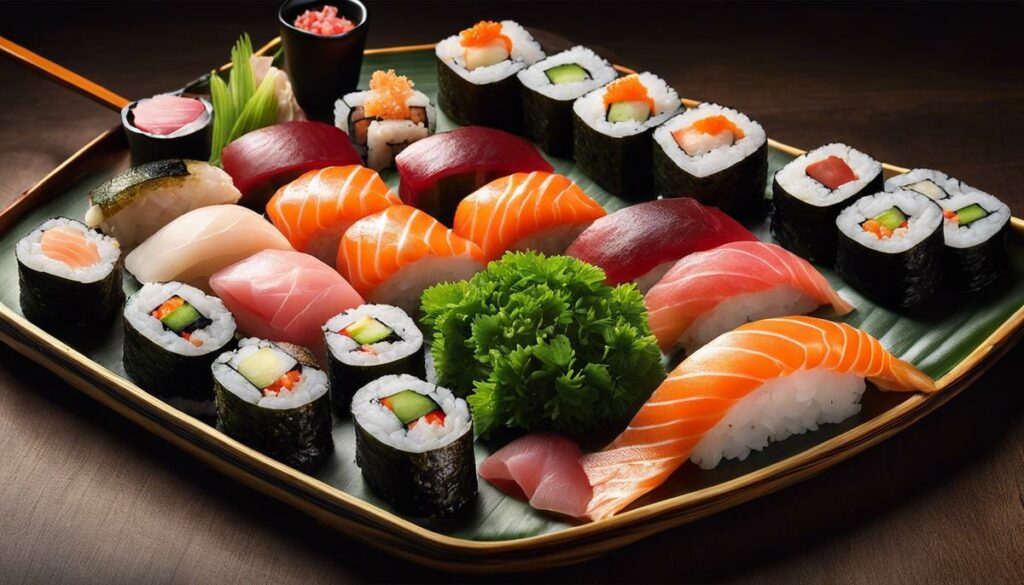The discreet murmur of a sushi restaurant is more than just the soundtrack of a dining experience – it’s the echo of a fascinating journey that has left every ingredient on your plate behind. This journey begins deep in the open ocean and passes through traditional rice fields, bustling fish markets and mysterious spice bazaars before finally ending in the artful hands of a sushi master. Our endeavor in this essay, therefore, is to explore the complex journey of sushi – from its birth as a canning method to its renaissance as a worldwide culinary phenomenon – uncovering the rich stories and traditions that are deeply rooted in its heart.
The History of Sushi
The Fascinating History & Evolution of Sushi: A Culinary Phenomenon
The fabulous world of sushi constantly holds us under its magical spell. This Japanese dish, usually beautifully presented and garnished, plays with colours, textures and explosive flavours – a sensory rush that goes far beyond the palate. But how did sushi evolve over time and become the food we know and love today? Embark on this culinary journey through time.
In the deep origins of Southeast Asian history, sushi was not the refined dish we know today. It started about 2000 years ago as a type of preservation method – fish was stored along with boiled rice to prevent spoilage. The rice that fermented over time was thrown away while the fish was being eaten. At the time, it was, to say the least, a stark sight to the elegant sushi platters of today.
In the 17th century, the greatest gastronomic breakthrough revolutionized Japanese cuisine. By discovering rice vinegar, they were able to ferment the rice and make it edible at the same time. This was the birth of the modern sushi we know today – rice and fish consumed together. It was a turning point in culinary history that changed the eating habits of the Japanese and later the worldwide sushi lovers.
Over time, sushi became more and more creative and flavorful. In the Edo period (1603-1868) the “Edomae-zushi” was created, which was intended for the fast urban lifestyle of the city dwellers. This fast food sushi, which used raw fish and seafood caught in Edo Bay, quickly became popular.
In the 19th century, the rapid change in Japan’s political, social, and cultural life met all the conditions for the sushi we love and appreciate today. With the development of the refrigerator, sushi producers could now access a variety of seafood and develop their culinary skills, resulting in the diversity and originality of modern sushi.
Nowadays, sushi has an impressive range of variations:
- “Maki” (rolled sushi)
- “Nigiri” (fish pressed on rice)
- “Sashimi” (fish only)
- Western creations such as “California Roll”
Sushi has established itself as a creative, timeless and popular food, and has secured a firm place on the global culinary scene thanks to its unique expression and sheer endless possibilities.
The history and evolution of sushi is a remarkable testimony to the connection between culture, art and cuisine. It has evolved from a simple preservation method to a social experience and a global culinary phenomenon. In any case, sushi is not boring – it is a delicious journey that offers endless joy and energy, just like our lives themselves.
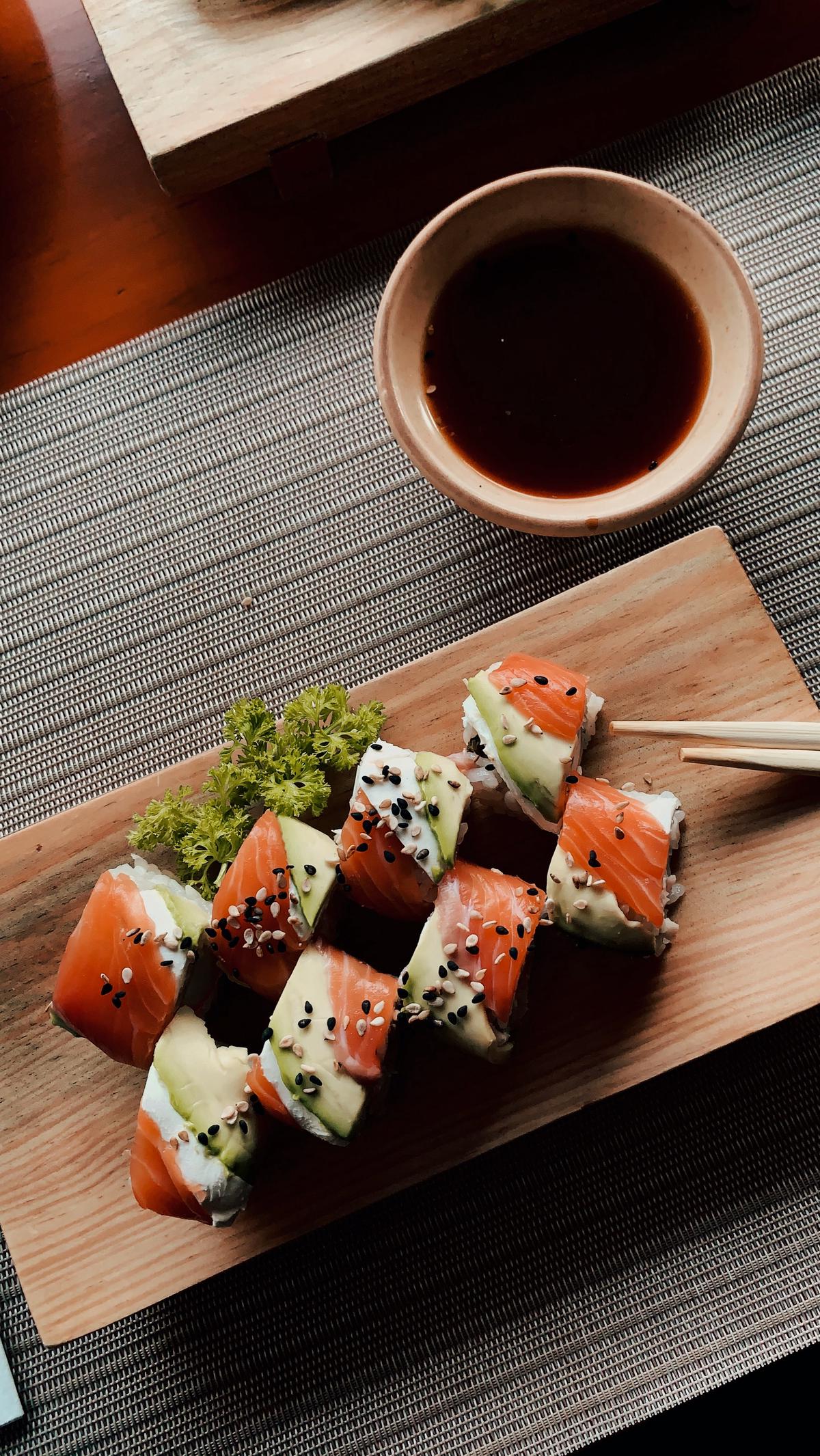
Photo by derekduran on Unsplash
The origin of the ingredients
Title: High-Quality Ingredients for Sushi: The Origin and Their Importance
That sushi is not just a meal, but an art form, is well established at this point. But what exactly makes sushi such a culinary delight? Much of this is due to the quality and origin of the ingredients used in the preparation. The special thing about sushi is the specially selected, high-quality ingredients, because every aspect of the preparation is of great importance.
Sushi rice, for example, stands out for its mild taste and sticky consistency. Grown with the utmost care by Japanese farmers, this short-grain rice is the basis for any sushi creation. The use of rice vinegar to flavor rice has its roots in the Edo period and contributes significantly to the unique flavor profile of sushi.
Let’s move on to the fish. It doesn’t get any fresher than this – that’s the motto of sushi. Whether salmon, tuna, mackerel or eel, almost any type of fish can be processed into sushi. But where do these quality products come from? The answer lies in the cold, clear waters around Japan. These offer a variety of marine life and fish, which are caught in traditional craftsmanship and carefully selected. In addition to the catch, traditional Japanese preparation also plays a key role – fish is often pickled or fermented to extend its shelf life and bring out its unique taste.
In addition to rice and fish, other ingredients are also gaining importance in sushi, such as the nori sheet, which consists of dried and pressed seaweed. This nutrient-rich seaweed is harvested from the coasts of Japan and is an indispensable ingredient in many sushi varieties.
Freshly grated wasabi and pickled ginger are also essential. Both ingredients, deeply rooted in Japanese cuisine, go through a meticulous refinement process and have impressive taste qualities that round off the sushi experience.
In the soy dip, the soy sauce plays an important role. Handcrafted from soy, wheat and koji mushroom, it is considered the heart of Japanese seasoning techniques and rounds out the sushi composition with its deep, complex flavors.
Overall, it’s the relationship between these fine, meticulously selected ingredients that makes sushi a sophisticated explosion of flavor. It is this fine balance that allows each ingredient to have its own stage, while at the same time forming a harmonious whole. So it’s clear: high-quality ingredients and their origin play a central role in the art and science of preparing sushi.
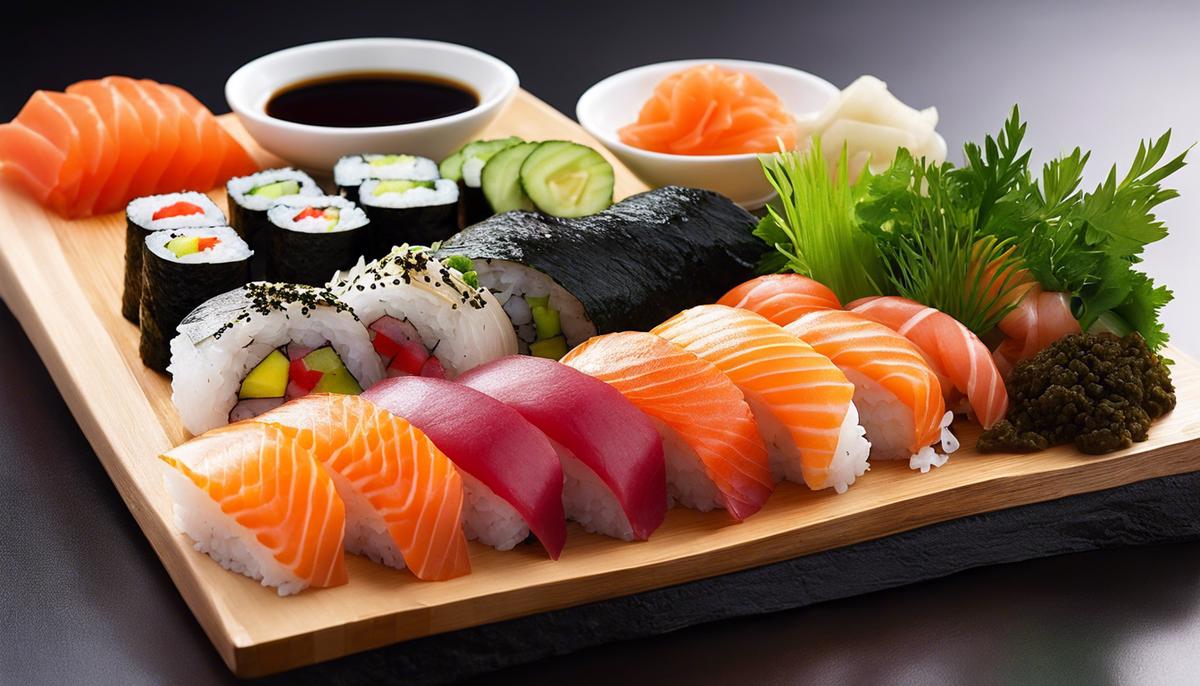
The Art of Sushi Preparation
At the heart of the sushi experience is professionalism and skill. Beyond the recipe ingredients, the secret to making the best-tasting sushi often lies in the method and attitude of the sushi chef or master. A professional sushi chef is often referred to as an ‘itamae’ or in front of the cutting board. The role of an Itamae goes far beyond simply making sushi and encompasses a wide range of skills and knowledge gained through years of training and experience.
An important aspect in the preparation of sushi, as practiced by professional sushi chefs, is to maintain simplicity and naturalness. Each ingredient is carefully selected to accentuate the natural flavor rather than hide or alter it. For example, strong fish is usually not selected so as not to mask the delicate taste and texture of the rice.
The techniques and skills used in the preparation of sushi are equally essential. The filigree cutting of fish requires precision and years of practice. For a sushi master, cutting is more than just a technique – it’s a form of art. Each cut is made with complete concentration and respect for the ingredients.
One of the most closely guarded secrets of the best sushi masters is the preparation of the sushi rice. The rice cooking process is critical and requires care and attention. The special sushi rice must be cooked to the optimal point, so that each individual grain of rice is individual but not too hard and offers the perfect balance of “al dente” and softness.
Apart from the practical aspects of sushi preparation, the aesthetic arrangement also plays an important role. The presentation of sushi is an art in itself. A pile of sushi on a plate acts not only as a visual delight, but also as an invitation to enjoy the food.
Finally, another secret to the success of the best sushi masters is their dedication and passion for their art. They are constantly striving to perfect their craft while preserving the purity and authenticity of traditional sushi making. In their pursuit of perfection, sushi represents more than just a dish – it’s a reflection of their professionalism, pride, and dedication to their craft.
Thus, the preparation of sushi is a complex harmony of high-quality ingredients, masterful technique, aesthetic presentation and passionate craftsmanship. This makes sushi an incomparably delicious and at the same time deeply cultural experience.
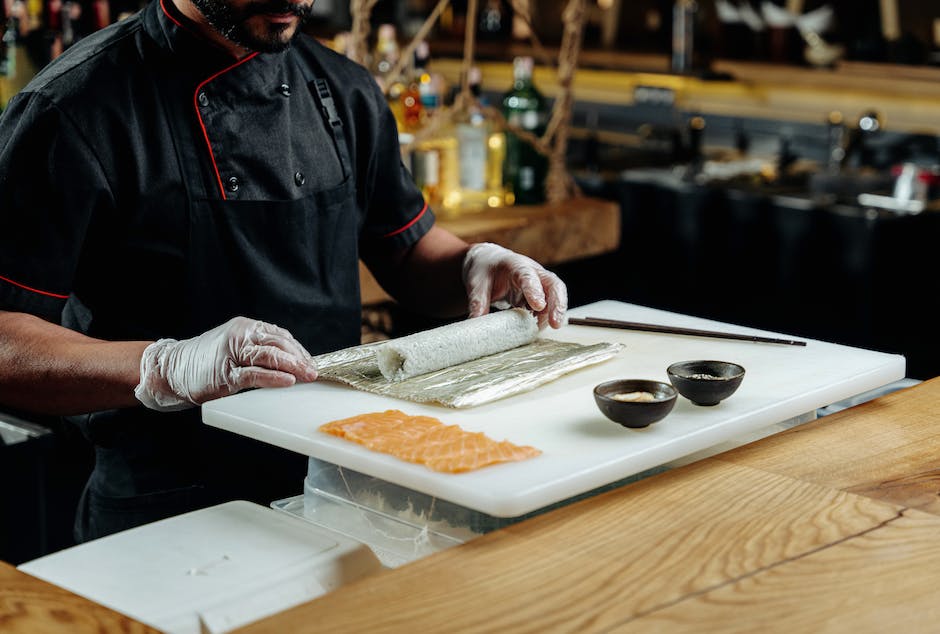
The importance of sushi in society
After all, sushi isn’t just a dish, it’s an art form. From the selection of the best ingredients to the ceremonial of the meal, the sushi experience is filled with a heartfelt respect for the tradition and process behind it. How this reverence has influenced the way we think about gastronomy is immeasurable.
One of the most notable effects of the sushi boom is the rising appreciation for raw fish in general. Choosing the right fish requires the highest level of expertise and a keen eye for quality. It’s all about catching the fish at its best freshness when it’s just reached its maximum flavor. This concept has been perfected by sushi masters and is now influencing other areas of gastronomy as well.
If we look at parts of the world such as North America and Europe, where sushi now enjoys a ubiquitous presence – we find eye-catching reinterpretations of this traditional Japanese art. From metropolitan fusion restaurants to minimalist pubs, the magic of sushi has changed the culinary landscapes of these countries forever.
With this proliferation, there is also a cultural exchange – international chefs are incorporating sushi preparation techniques into their own culinary creations, resulting in exciting innovation on the plate. It is the blend of tradition and restraint that underlies sushi that has led to many expansions of the culinary vocabulary of chefs around the world.
It’s remarkable how sushi has gone far beyond its place of origin, leaving its mark on almost every corner of the world. Today, sushi can be found in almost every city, from the smallest villages in Northern Europe to vibrant metropolises like New York. In some larger cities, grocery stores, canteens and cafes are even selling sushi-like products.
But not only that – sushi has even made its way into the fashion and design world. Think sushi socks, trinkets, craft projects, even nail designs – the sushi aesthetic is everywhere.
In short, sushi has transformed and reshaped global culinary, cultural, and even aesthetic landscapes. It’s not just a meal, it’s a way of life, an interpretation of taste and a demonstration of a cross-cultural phenomenon that continues to push the boundaries of tradition and innovation. And just as the ever-changing world exerts its influence on sushi, sushi throws its own influence back into the world. And that’s what makes it so memorable.
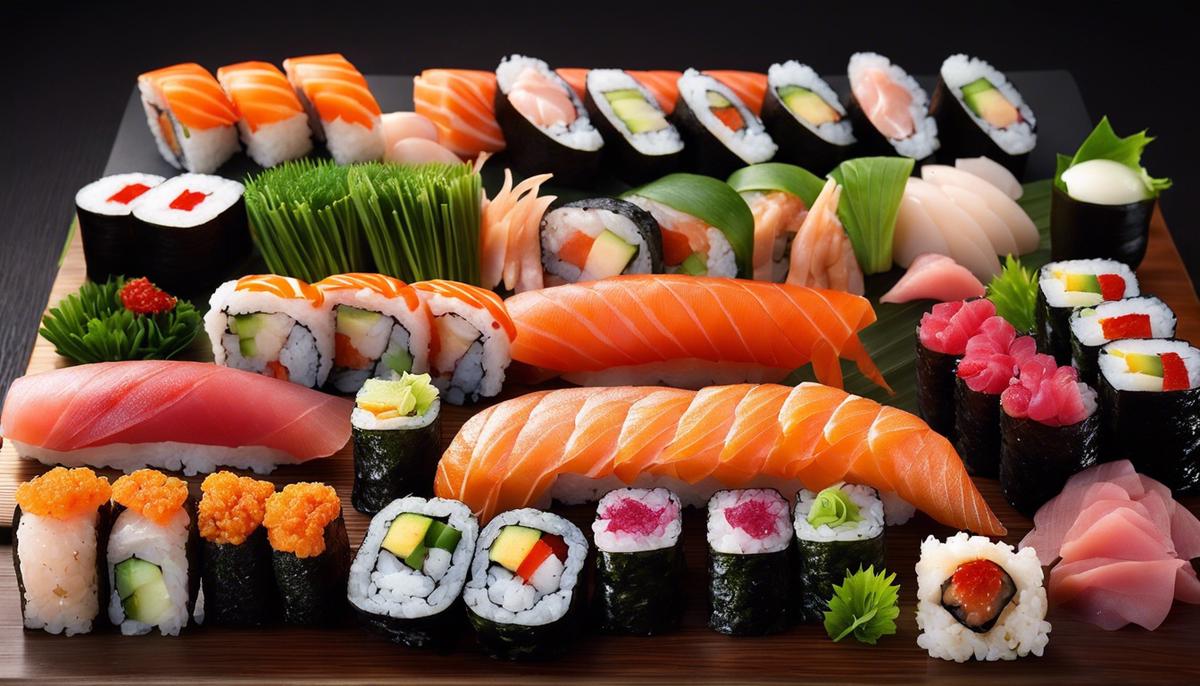
The Future of Sushi
So what can we expect in terms of future trends? How will the fascinating sushi universe evolve?
A growing trend is vegan and vegetarian sushi. With the growing popularity of vegan and vegetarian lifestyles and the pursuit of a healthy diet, sushi is developing a lot. Plant-based sushi variations, which use seasonal and colorful fruits and vegetables, are not only visually appealing, but also nutritionally very exciting. This development shows that sushi does not only have to include fish, but also allows for the introduction of more plant-based ingredients.
Sushi restaurants, with their impressive sushi bars and artistic presentations, are becoming more and more upscale and now often offer wine lists . The pairing of sushi and wine is a relatively new trend that is gaining more and more traction in finer sushi restaurants. When choosing the right wine, attention is paid not only to the taste of the fish, but also to the sauce and spices used in the sushi.
Another notable trend is fusion cuisine. Many creatives are experimenting with different culinary traditions, combining sushi with elements of other cuisines. Just think of the Korean-Japanese fusion with gimbap or the Texan-Japanese fusion with smoked brisket sushi.
The immersive technologies are also being used more and more in the sushi world. In Japan, there are already restaurants that use augmented reality ( AR ) and virtual reality (VR) experiences to provide customers with a unique dining experience. In addition, courses are offered where you can learn how to prepare sushi or master the fine art of filleting fish.
To stay in tune with the sustainable movement , there is an increasing tendency to use locally caught and sustainably farmed fish. This is not only good for the environment, but also promotes the local economy and guarantees the freshness of the fish used in sushi.
In the future, the hype around sushi might be hard to stop. With all these new trends and developments that we are already experiencing, we can be sure that the universal phenomenon of sushi will accompany us for a long time to come, surprising and inspiring us again and again. With every bite we take of this venerable food, we are always reminded of the deep-rooted tradition and heritage that has developed over centuries and yet still leaves enough room for innovation and creativity.
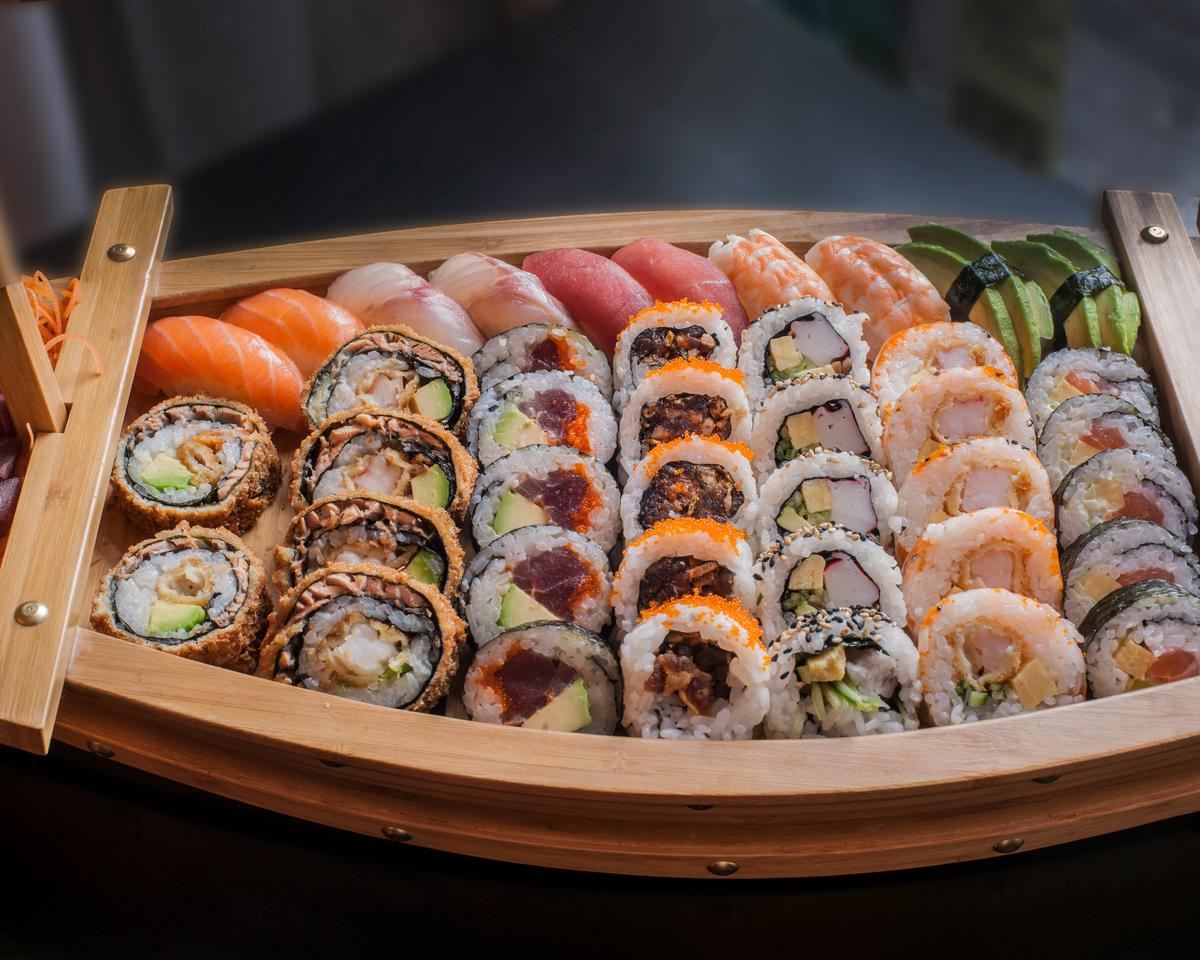
Whether it’s honoring the past, celebrating the present, or tuning in to the future possibilities, the world of sushi is constantly being redefined and expanded. With every freshly cut fish, every handful of cooked rice and every careful garnish, new chapters are written in his exciting chronicle. In an ever-changing global landscape, sushi remains a constant reminder of people’s ability to create the best of nature’s gifts. It symbolizes the harmony between culture and nature, tradition and innovation, craft and art – a harmony that could resonate even more in the future as sushi continues to build on its well-deserved reputation as a luxurious yet accessible gourmet food.
